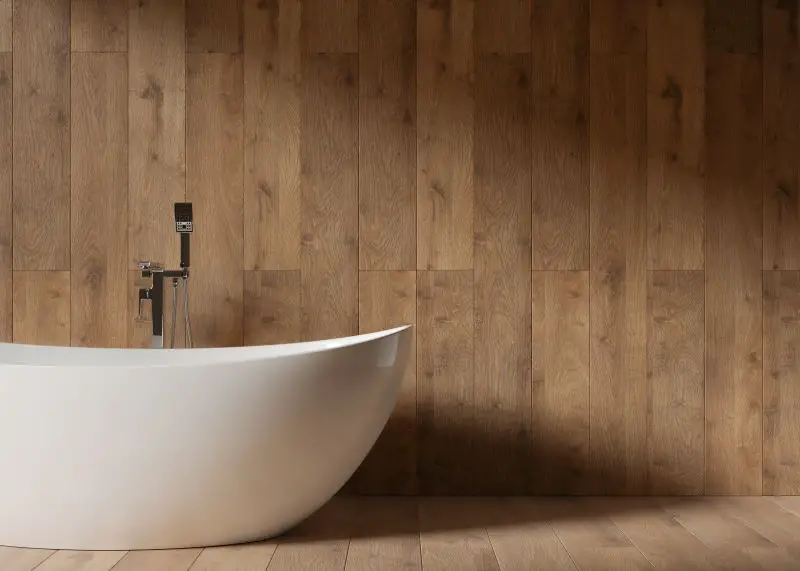Click here to get this post in PDF
When it comes to renovating or designing a bathroom, selecting the right flooring is crucial. Bathrooms are high-moisture areas, prone to spills, splashes, and humidity. While tiles and vinyl have been the traditional go-to choices for bathroom flooring, engineered wood flooring has been gaining popularity for its aesthetic appeal and durability. But can engineered wood flooring be used in bathrooms? Let’s delve into this question and explore the possibilities.
Understanding Engineered Wood Flooring
Engineered bathroom wood flooring is a versatile and popular choice for many homeowners and professional property developers. It is constructed with multiple layers of wood veneers stacked and glued together under heat and pressure. The top layer, known as the wear layer, is made of real hardwood, providing the authentic look and feel of solid wood flooring. Beneath the wear layer, there are layers of plywood or high-density fiberboard (HDF), offering stability and strength to the flooring.
The Benefits of Engineered Wood Flooring
Before diving into its suitability for bathrooms, let’s highlight some of the advantages of engineered wood flooring:
1. Moisture Resistance: Unlike solid hardwood flooring, engineered wood flooring is less susceptible to moisture damage due to its layered construction. The plywood or HDF core provides stability, reducing the risk of warping and swelling caused by moisture.
2. Aesthetic Appeal: Engineered wood flooring offers the timeless beauty of real hardwood, enhancing the visual appeal of any space. It comes in a variety of wood species, finishes, and plank sizes, allowing for customization to match your design preferences.
3. Durability: Engineered wood flooring is engineered to withstand heavy foot traffic, making it suitable for high-traffic areas like bathrooms. The top layer of real hardwood provides durability and resistance to scratches and dents, ensuring longevity.
4. Easy Installation: Engineered wood flooring often comes in planks with click-lock or tongue-and-groove systems, facilitating easy installation. This DIY-friendly feature can save time and money on installation costs.
Factors to Consider for Bathroom Wood Flooring
While engineered wood flooring offers several benefits, its suitability for bathrooms depends on various factors:
1. Moisture Levels: Bathrooms are inherently high-moisture environments, with frequent exposure to water from showers, baths, sinks, and toilets. While engineered wood flooring is more moisture-resistant than solid hardwood, prolonged exposure to moisture can still cause damage over time. Maintaining proper ventilation and promptly wiping up any spills or standing water to prevent moisture from seeping into the flooring is essential.
2. Waterproofing: To enhance the moisture resistance of engineered wood flooring in bathrooms, consider applying a waterproof sealant or coating. Several manufacturers offer engineered wood flooring with enhanced waterproof properties, designed specifically for areas prone to moisture exposure. These waterproofing treatments can provide an additional layer of protection against water damage.
3. Maintenance: Proper maintenance is key to preserving the integrity of engineered wood flooring in bathrooms. Regular cleaning with a damp mop and mild detergent is recommended to remove dirt, grime, and excess moisture. Avoid using harsh cleaning products or excessive water, as these can damage the wood surface or penetrate the seams between planks.
4. Subfloor Condition: Before installing engineered wood flooring in a bathroom, ensure the subfloor is level, dry, and structurally sound. Address any issues with moisture or unevenness before laying the flooring to prevent problems down the line.
Alternatives to Engineered Wood Flooring
If you’re hesitant about using engineered wood flooring in your bathroom, there are alternative flooring options to consider:
1. Porcelain or Ceramic Tile: Tile flooring is a classic choice for bathrooms, known for its water resistance, durability, and easy maintenance. It comes in a wide range of colors, patterns, and textures, allowing for endless design possibilities.
2. Vinyl Flooring: Vinyl flooring is another popular choice for bathrooms due to its affordability, water resistance, and low maintenance requirements. It replicates the look of natural materials like wood or stone while offering superior moisture resistance.
3. Laminate Flooring: Laminate flooring combines the aesthetic appeal of hardwood with the durability and moisture resistance of engineered materials. While not recommended for wet areas like bathrooms, certain types of wood flooring with water-resistant properties may be suitable for use in bathrooms with proper precautions.
Making the Right Choice
In conclusion, while engineered wood flooring can be used in bathrooms, carefully considering factors such as moisture levels, waterproofing, maintenance, and subfloor condition is required. With proper installation, maintenance, and precautions, engineered wood flooring can provide a beautiful and durable flooring solution for your bathroom. However, if you’re unsure about its suitability or prefer alternative options, plenty of other flooring choices are available to meet your needs and preferences. Whether you opt for engineered wood flooring, tile, vinyl, or laminate, choose a flooring material that complements your design aesthetic and withstands the unique challenges of your bathroom environment.
So, can engineered wood flooring be used in bathrooms? The answer is yes, but with careful planning and maintenance to ensure its longevity and performance in a high-moisture environment.
You may also like:
How To Handle a Restroom Backup in the Office
7 Secrets of Superb Stone Veneer Work: The Ultimate Guide For Start-Up Stone Masons
Image source: elements.envato.com

